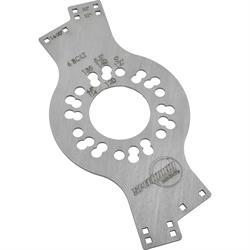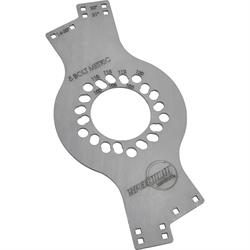How Big of Tires Can I Fit - Plus Sizing Guide
Get Your Traction in Action!
Increasing a tire's contact patch means more traction and better braking ability along with better handling. These are all things we want to improve on our vehicles and upsizing tires or plus sizing tires is certainly one way to do it. That said, the big question on every enthusiast’s mind is going to be “how big of tires can I fit on my ride?” Our line of wheel fitment simulators will certainly help answer that question, but first we need to discuss the benefits of upsizing tires or plus sizing tires on your ride.
Tire Plus Sizing Guide
Are Wider Tires Better?
When you consider the OEM tire size, or even a popular upgrade used in the past, for the typical hot rod or muscle car it is easy to see how modern tire widths and their lower aspect ratios have become so popular. While a lot of this is driven by aesthetics, there is a lot of good in going with a wider tire on your vehicle. We are referring to both front and rear fitments here too, not just a big meaty rear tire, so put away those air shocks!
Upgrading to wider rubber provides many advantages, including increased traction in both wet and dry surfaces, better braking, and increased high speed stability and handling. This happens for several reasons. The main reason you’ll see more traction ability and improved braking is the wider tire’s contact patch creates more friction with the road surface. Increasing a tire’s width increases the amount of rubber in contact with the road surface, AKA the contact patch. The more rubber gripping the road, the more braking and traction can be improved. It’s not a matter of is it safe to upsize tires, but why haven’t you done it sooner!
It doesn’t matter if you have huge 14-inch disc brakes if you have a 5-inch wide tire trying to stop the car. You’ll simply lock the front tires and slide. A wider tire will have more grip, and hence more braking up to that full lock, which will happen less easily with a wider tire. The same is true for acceleration and traction. We all know how easy it is with a stout small block to light up a set of F70/14s but increase your tire width to something like a 275/50R15 and your available traction increases due to a 50 percent increase in tread width, making it harder to spin those tires. That is the advantage of wider tires.
From a handling standpoint, wider tires usually come with a shorter sidewall (aspect ratio) as well, especially when the owner opts to upgrade to a modern wheel size of 16 inches or larger. The combination of increased contact patch and a shorter sidewall means that the tire squirms less at speed, increasing high speed stability. The shorter sidewall is also stiffer, which firms up handling when getting on it in the corners. Thus, a wider tire with a lower aspect ratio that will fit in your wheel well, clearing brakes and suspension pieces is the perfect all-round upgrade that improves handling, braking, and traction.
If there is any down side to wider tires is there is a small increase in rolling resistance, which in turn means a dip in fuel economy. This rolling resistance also can cause raised road noise levels, though that is often dependent on the actual tread block design. Finally, wider tires may come with an increased cost versus the tires you buy now. Again, this would be dependent on the size and brand purchased, but something to think about. Overall, a little more road noise and a bit more fuel usage is rarely a concern for an enthusiast looking for maximum traction, handling, and braking.
Are Bigger Tires Better?
When we are referring to “bigger” tires we are in fact meaning a taller tire. Going to a taller tire, either one with more sidewall or by increasing wheel diameter and maintaining a low profile aspect ratio, can provide some traction benefits as well. While a wider tire increases the width of the contact patch with the road surface, a taller tire increases the contact patch length wise a small amount, creating a longer, but narrower contact patch. As we noted previously, a taller tire with more sidewall will help with road noise and soaking up road imperfections as well if you’re looking for a quieter, smoother ride. However, it does affect handling and high speed stability due to the larger, more flexible sidewall. Changing tire size on same rim you are running now is possible, up to a point, then you’ll want to look at going to wider wheels with a different offset.
One way to have the best of both worlds is to run a taller tire but on a larger diameter wheel, this is often referred to as plus sizing tires. Upgrading from a 26-inch tall tire to a 28-inch tall tire but also upgrading from a 15-inch wheel diameter to say an 18-inch wheel diameter at the same time will provide the better handling and stability we discussed with wider tires while also providing that taller tire to fill your wheel well or provide the look you’re after. Also realize that whether you go wider or taller (or both!) that vehicle weight and tire pressures will also affect contact patch.
The heavier your vehicle the more pressure on the tire to the road surface, increasing the contact patch. Tire pressure will affect contact patch as well and needs to be adjusted for each tire size and vehicle weight to ensure optimal contact patch and even tread wear. Know that there is no magic tire pressure setting. Two vehicles with identical tires, but one weighs 2,300 pounds and the other weighs 3,600 pounds, will have different tire pressures to optimize the contact patch. Once you determine the correct pressure for your combination it is simply a matter of checking your tires during routine maintenance to maintain these tire pressures. Modern tire pressure monitoring systems (TPMS) have been found by the DOT to be more effective in owners maintaining their proper tire pressures. Today you can run a TPMS system in your classic car using a smartphone app for monitoring. Fun fact, you can determine your vehicle’s weight using tire pressures and measuring the contact patch with some basic math and a little work.
Tire Upsizing Calculators Are Flawed
There are a lot of online tire calculators available and even smartphone apps that will provide dimensional data on increasing tire size. Some will even compare two different tire sizes with a visual aid showing how the two sizes differ in width and height when upsizing tires. While a tire upsizing calculator will work well for this dimensional data of the tire itself, they will not answer the question of how big of tires can I fit on your exact vehicle. Yes, there are some websites with vehicle data that will provide a “yes/no” as to vehicle fitment, but that is for a completely stock vehicle and often does not go back far enough to aid in confirming installation fitment on classic muscle cars, trucks and hot rods.
Even more so an issue is when these vehicles have been altered with different axle housings, aftermarket suspensions, or even physical body modifications such as wider fenders. None of these calculators really show how to upsize tires for your exact combination. In such cases the only way to 100 percent confirm the tire size you plan to use will fit is with a tire fitment tool that allows the tire to be fitted to the car so that clearances can be checked and confirmed with regards to the body, suspension, and more. Only then will you have the information needed to know how big of tires can I fit to your ride by measuring for wheel dimensions specific to your application.
How Much Tire Clearance Do I Need?
Tire clearance between the body and any suspension components is critical to prevent tire damage which can lead to vehicle damage contacting the road surface or worse, a collision with an object or another vehicle. When considering wider and/or taller tires maintaining a minimum 1/4-inch of clearance is suggested. If possible, a ½-inch of clearance is preferred just to ensure there is sufficient room to account for tire growth/sidewall deflection. Pay special attention to the wheel lip openings, which may require “rolling” or other modifications for tire clearance.
To best confirm these fitment clearances when increasing tire size, you will have to physically mount the tire size you plan to use in the wheel opening and cycle the suspension and steering through their full range of motion to validate a safe fitment. The best way to be able to do this is with a wheel and tire mockup tool such as our line of wheel fitment tools. These tools, and their optional lug center plates, allow you to test fit tires from 14 to 20 inches in diameter and from 7 to 17 inches in width and adjust the wheel’s backspacing to best place the tire in the body opening. Available in standard or metric 5-lug options, plus 4-lug and 6-lug versions, it’s the perfect shop tool to determine if a wider and/or taller tire will live harmoniously with your vehicle’s steering, suspension, and body openings.
How to Fit Bigger Tires (Cars & Trucks)
Now that you’re certain upgrading to wider tires is the right thing for your ride, ensuring that new tire size is going to fit is your final step, especially if you’re going to be ordering new wheels to fit said tires. Below we’ve outlined the steps on how to put wider tires on a car to using our wheel fitment tool. This will also work well if you want to learn how to fit bigger tires on a truck too by simply utilizing the proper lug mounting plate for your bolt pattern. If you need it, here is a refresher course on how to read a tire sidewall.
Once you have gained proper clearance remove the assembly and note the following for ordering your new or custom wheels:
- Bolt Hole Pattern
- Wheel Diameter
- Wheel Width
- Wheel Backspacing
If you’re planning to order new wheels this section width chart may assist you in determining the best rim width for the tire size you plan to use.









